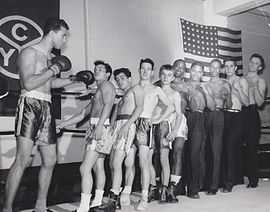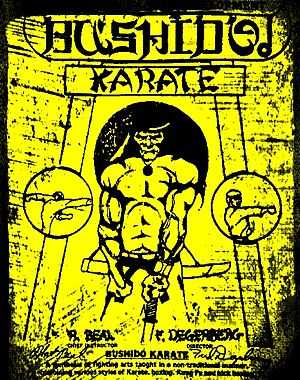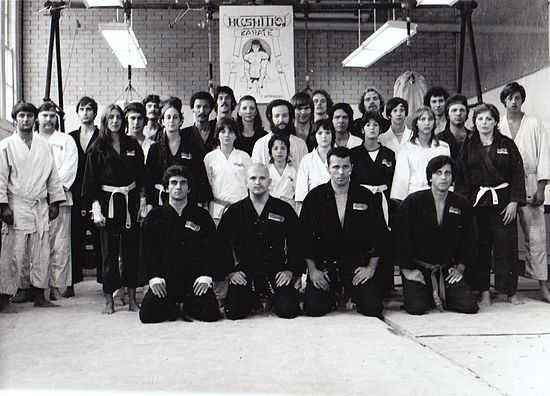Robert Brutus Beal
| Bob Beal | |
|---|---|
 Robert Beal | |
| Born |
Robert Brutus Beal February 22, 1938 Chicago, Illinois |
| Other names | Bobby Beal, Bob Beal |
| Nationality | United States |
| Height | 6'3" |
| Weight | Heavyweight |
| Fighting out of | Chicago, Illinois |
| Trainer | Tony Zale, Harold "Ray" Lett, Frank Beal, Johnny Coulon |
| Amateur career | |
| Total | 300 |
| Wins | 291 |
| By knockout | 175 |
| Losses | 9 |
| Other information | |
| Occupation | Woodworker |
| Spouse | Josephine Hubert |
| Notable relatives | Harold "Ray" Lett |
| Notable students | Fred Degerberg, Johnny Lira |
| Notable club(s) | Catholic Youth Organization |
| Notable school(s) | Bushido Fighting Society, Degerberg Academy |
Robert Brutus Beal (born February 22, 1938) is a retired amateur boxer and founder of Bushido Karate. Beal is a 10th Degree Black Belt, or Red Belt, in Bushido Karate. His mother was from Minnesota, and her family had a reputation as vicious fighters. Beal was known for his vicious punching power, which some claim is among the best ever. One boxing reporter wrote that Beal "hit like Jack Dempsey and Joe Louis rolled into one" and another claimed Beal's "fists were like the hammers of hell."[1] One journalist called Beal "superhuman."[2]
Early Life and Boxing
Beal was trained by his father, Frank Beal, and uncle Harold "Ray" Lett. Frank Beal was trained by Billy Miske, a fighter who amazed the world when he defeated Bill Brennan as he was dying of Bright's Disease and couldn't even train for the fight because of his illness. Robert Beal's uncle, Harold "Ray" Lett, a firefighter who fought under the name Ray Vegas, once battled heavyweight champion Jack Dempsey to a bare-knuckle draw.[2] Frank Beal and Ray Lett started training Robert Beal at the age of seven. Even at a young age, Beal trained tirelessly. As a child he would spar much older opponents in his family's garage-turned gym. When he was just twelve years old, Beal began going to pro gyms to train. Again, Beal would spar with much older opponents, however this time the opponents were amateur or pro boxers. Beal would train six to nine hours a day. Everyday after school Beal would go to the gym to spar and train with Chicago boxing legend Richard Guerrero.[3] Beal developed a friendship with Guerrero, and learned valuable lessons about the art of boxing.
Former 2-time world middleweight champion Tony Zale was one of Beal's trainers. Boxing legend, hall of famer, and former Bantamweight champion, Johnny Coulon, was also one of Beal's trainers and mentors.
In the Catholic Youth Organization championships, the head of the CYO, Mike Triolo, made Beal wear 16 oz. gloves in fear that Beal might severely injure an opponent. Although he had to wear thicker gloves, Beal still knocked all of his opponents out in the first round.[4]
In the 1955 championships heavyweight division, in a bout to qualify for the 1956 Olympics, Beal fought Cleveland Sports Hall of Fame Inductee Pete Rademacher[5] and won the bout, knocking Rademacher out. However, Beal broke his hand and could not compete in the Olympics, allowing Rademacher to qualify.
Beal beat Monte Hendricks to win the 1956-1957 Sugar Bowl Heavyweight championship. The Sugar Bowl fights, which were the championship bouts between the champions of the South versus the champions of the North, were held in New Orleans, Louisiana.

Beal had a successful amateur boxing career, unfortunately Beal was told by doctors that further damage to his oft broken hands could have held severe consequences, so instead of going pro, Beal went into wrestling for a few years then began training in martial arts. By not going pro, Beal went against the wishes of boxing legend Rocky Marciano, who thought Beal would have made a great professional boxer.[6] Although Robert Beal never made it to the professional status, he still is a decorated boxer with many accolades. Although Beal missed out on the 1955 Golden Gloves and Olympics, Beal had the pleasure of beating many who qualified for both teams. Beal was well known throughout Chicago as a vicious boxer who usually won his fights via one round knockout.
Life in the Fighting Arts
After his boxing career ended, Beal decided to train in wrestling. Former junior heavyweight wrestling champion Billy Goelz[7] trained Beal in wrestling and helped further Beal's skills in hand to hand combat.
Fighting was a pastime for Beal, so it was only a matter of time before Beal started to train in martial arts. Beal trained in judo, karate, aikido, yoga, tae kwon do, kung fu and jujitsu. He just kept getting better. He would train six to nine hours a day, maniacally practicing moves until he was absolutely perfect. Boxing had already given him the conditioning, strength, and timing he needed. Beal always kept close to boxing, the style in which he enjoyed so much success in.


During his time as an instructor, Beal trained and mentored many people. Beal trained lightweight boxing contender Johnny Lira. He also trained many members of the Chicago Police Department. Beal retired from instructing in 1997.
Beal was featured in Black Belt Magazine in the February 1986 and September 1988 issues. He is featured in the article "The Degerberg Academy"[9] in the 1986 issue and is mentioned in the "School of the Month"[10] article in the 1988 issue. Beal was featured in the Chicago Daily News in a 1977 Sidetracks article titled "Martial arts mix master: Bob Beal's Bushido way of battling."
Beal currently resides in Des Plaines, Illinois with his wife, Josephine, his children; Cora and Jeanne, and his grandchildren; Michael, David, and Dylan. Those who know Beal know that he won't stop searching for ways to perfect whatever he is doing. Beal is an avid woodworker, often spending the same amount of time on his projects as he once did training in boxing and the fighting arts.

References
- ↑ Degerberg Acadmemy Black Belt Ceromony Introduction
- ↑ 2.0 2.1 2.2 2.3 Pollack, Neal (February 26, 1998). "Feet Fightin' Man". The Chicago Reader. Retrieved 31 February 2013.
- ↑ http://boxrec.com/media/index.php?title=Human:290965
- ↑ Degerberg Academy Black Belt Ceremony with Speech about Robert Bealhttp://www.youtube.com/watch?v=XyrA9k9kItA
- ↑ http://clevelandsportshall.com/rademacher-pete/
- ↑ Degerberg Academy Black Belt Ceromony with Speech about Robert Bealhttp://www.youtube.com/watch?v=XyrA9k9kItA
- ↑ http://www.onlineworldofwrestling.com/bios/b/billy-goelz/
- ↑ http://www.degerbergacademy.com/
- ↑ Groak,Willam (February 1986). "The Degerberg Academy" Black Belt Magazine
- ↑ (September 1988). "School of the Month"Black Belt Magazine